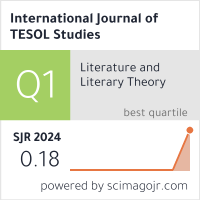2632-6779 (Print)
2633-6898 (Online)


Scopus
Ulrich’s Periodicals Directory (ProQuest)
MLA International Bibliography
MLA Directory of Periodicals
Directory of Open Access Journals (DOAJ)
QOAM (Quality Open Access Market)
British National Bibliography
WAC Clearinghouse Journal Listings
EBSCO Education
ICI Journals Master List
ERIH PLUS
CNKI Scholar
Gale-Cengage
WorldCat
Crossref
Baidu Scholar
British Library
J-Gate
ROAD
BASE
Publons
Google Scholar
Semantic Scholar
ORE Directory
TIRF
China National Center for Philosophy and Social Sciences Documentation
Editorial
Anne McCabe
Saint Louis University, Madrid Campus, Spain
The seeds of SFL as a theory of language have gone hand in hand with applications to teaching from its inception, and SFL-based educationalists have promoted a pedagogy which is strongly rooted in descriptions of language as it is used in specific contexts and situations. Also, in the mid-1960s, Halliday’s applied work turned away from L2 teaching and towards his mother tongue English, thus towards the broader field of language education and literacy development in schools. In the 1980s, this focus was taken up in Australia to advance literacy needs in schools and the workplace, through work by scholars and educators such as Jim Martin, Francis Christie, Joan Rothery, and others, who drew on SFL descriptions of language as it is used in specific school subjects in order to create a genre-based pedagogy (GBP) (Martin, 1999; 2000). GBP and other SFL-based pedagogies, such as Reading to Learn (R2L) (Rose, 2006; Rose & Martin, 2012) and language-based pedagogy (LBP) (Clark, 2019), have experienced tremendous growth in application to primary and secondary schools around the world (McCabe, 2021), as evidenced, for example, by the inclusion of SFL as the main theory underpinning the WIDA Standards Framework and its theoretical foundations. WIDA (World-Class Instructional Design and Assessment) is a consortium of 41 U.S. state departments of education as well as around 500 international schools throughout the world, “dedicated to the research, design and implementation of a high-quality, culturally and linguistically appropriate system to support English language learners in K-12 contexts” (WIDA, n.d.) Included in its framework are tenets of SFL, with specific mention of the social semiotic systemic nature of language, which both constructs and derives meaning from context – including notions of register and of specific shapes of the languages of academic content areas (Westerlund & Besser, 2021).
However, it is a call for applications of SFL beyond these contexts of schooling that the articles in this special issue address. Given the focus in SFL on increasing repertoires of language resources, or the gains people make in having available to them a range of choices in linguistic elements to construct ideational, interpersonal, and textual meanings, the linguistic theory with its lexicogrammatical descriptions and its accompanying pedagogies can obviously be applied to any language development situation across the lifespan. The genres of schooling are sites of recontextualized knowledge-making and reproduction (Christie & Martin, 2007), whose curricular role may provide a stability which leads more readily to genre description and characterization, which can then be made explicit to students in order to enhance their chances of success in school (Schleppegrell, 2004). Moving beyond the genres of schooling into other contexts of language use thus brings other challenges for educators, as the genres encountered may be less homogenous and wide-spread, meaning that learners’ understandings of language need to flexible enough to be applied to an ever-increasing range of situations.